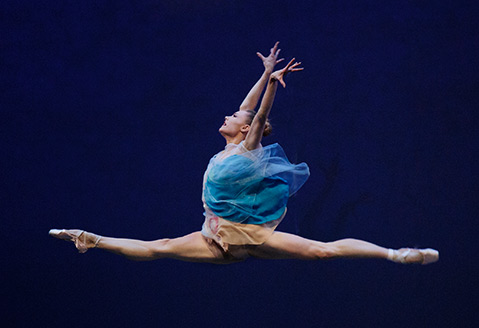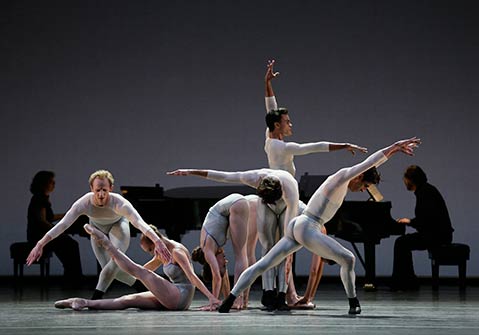N.Y.C. Ballet Moves
Two Nights and Two Programs at the Granada

An extraordinary season for lovers of dance in Santa Barbara continues this week as Moves, the touring company of the fabled New York City Ballet, arrives at the Granada for two nights, presented by UCSB Arts & Lectures. Each night will have a separate program, making this a kind of mini festival featuring some of the world’s greatest dancers in what is unquestionably a selection of the most interesting and important contemporary ballet choreography.
Ever since Lincoln Kirstein and George Balanchine founded the company in 1948, the name New York City Ballet has been synonymous with both innovation and achievement on the absolute highest level. In addition to employing an incredible roster of famous dancers over the years, the New York City Ballet has been home to a number of great choreographers. Jerome Robbins joined the organization just one year after it was founded, and after Balanchine’s death in 1983, Robbins and the great dancer, choreographer, and ballet master Peter Martins became responsible for the artistic direction of the company, which makes its home in Lincoln Center’s David H. Koch Theater.

The new century has been a good one for New York City Ballet and for the art form of ballet more generally. The great choreographers of the 20th century, such as Balanchine and Robbins, have been joined by a new generation with fresh ideas and the ability to create tremendous excitement in venues on multiple continents. Several of these artists are featured on the upcoming N.Y.C. Ballet Moves programs, including Christopher Wheeldon, Alexei Ratmansky, Peter Martins, William Forsythe, Justin Peck, and the company’s other ballet master, Jean-Pierre Frohlich. I spoke with Frohlich by phone from the company’s headquarters in New York last week, and he enlightened me as to the purpose and goals of the touring group Moves and gave some useful ideas about how to enjoy the pieces to be presented in Santa Barbara.
The upcoming engagement in Santa Barbara includes two programs over two nights. Is that the way that you prefer to arrange things? In this instance, the primary reason for the two nights is that the presenter, UCSB Arts & Lectures, wanted to put on both programs. I think that they are assuming that it will be essentially the same audience for both nights, and they have confidence that people who care about dance in Santa Barbara are interested enough to sustain that.
Can you say something about each of the programs? Of course. On Monday, October 26, the performance will open with “In Creases,” a new piece by Justin Peck, who is the N.Y.C. Ballet’s current choreographer in residence. He’s also a soloist with the company, and he will be premiering his first narrative ballet with the company in February of 2016. “In Creases” is set to music by Philip Glass, but you’d never recognize it as Philip Glass just from listening to it. The William Forsythe piece, “Herman Schmerman Pas de Deux,” is based on Balanchine, but it’s on a different level and goes to a different extent. The Jerome Robbins suite of dances was originally created for Mikhail Baryshnikov.
I understand that you are one of the people responsible for maintaining the legacy of Jerome Robbins. Could you talk about that? I was thrilled that he left this to me in his will. It’s an important job because on the one hand, you need to have him out there, and people need to perform his work in order that it live on. But on the other hand, you have to be careful about what kinds of productions you permit. It’s a bit like a marriage — the partners have to fit. One of the great things about Jerome Robbins’s work is how much dancers learn from doing it. Robbins was a master at going deep and creating dances in which the atmosphere and the intent are as important as the steps. Dancers need to experience that in order to grow as artists.
What is the mission of N.Y.C. Ballet Moves? Well, to bring a whole company on tour is just too expensive. The intent with Moves was to create a touring annex that leaves the core elements of the company experience intact. That’s why we always have at least some dances on the program that use live music, because that is such an important element. And really the idea is that when someone sees the Moves group in their home city, in Santa Barbara or San Diego for example, and then they travel to New York, they will have the New York City Ballet in mind as one of the things they might want to do there.
What do you see as the future for ballet today? A lot of people seem to think that ballet is dead, but they are misinformed. It’s not, and there are many young people coming into the ballet world who are moving it forward. Dancers are young! They have to be, and that’s the future. Of course there are things we can do to help, like offering tickets at affordable prices and giving more lecture demonstrations and open rehearsals. But just come out and see what’s happening, and you will understand that this art form is very much alive in this century.
4∙1∙1
N.Y.C. Ballet Moves is on Monday-Tuesday, October 26-27, at 8 p.m. at the Granada Theatre (1214 State St.). For tickets and information, visit artsandlectures.sa.ucsb.edu or call (805) 893-3535.



